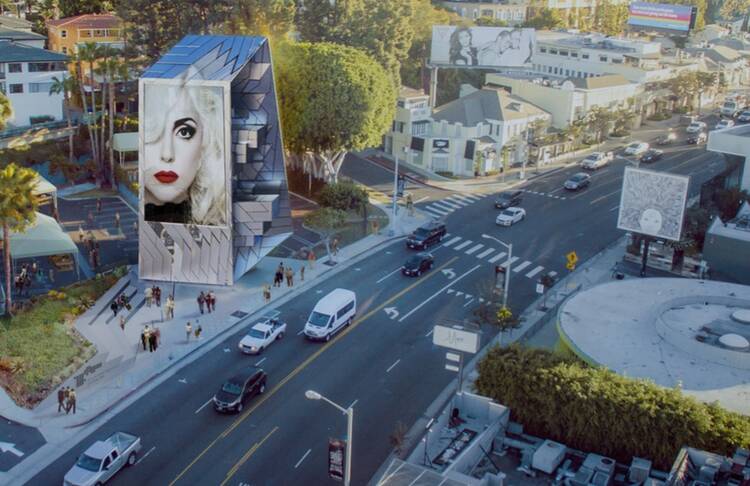Though many associate Los Angeles first and foremost with the Hollywood sign, palm trees or the handprints outside Grauman’s Chinese Theater, in fact the most iconic sights in the city might be the enormous billboards that hang along Sunset Boulevard. Combining celebrity, marketing and ostentation, these often-building length visuals capture the drives and priorities of the city and also the feeling of wonder Hollywood wants each of us to have. Particularly at night, a drive along Sunset can be a startling experience, each turn in the road presenting another gorgeous movie star or model smiling down, luminous, from on high.
Over the last year the West Hollywood City Council has been considering an intriguing wrinkle on this phenomenon: new community space built around advertisements. Looking for ways to innovate Sunset’s signature advertising, the council had originally proposed transforming a small frontage space on a parking lot into some sort of temporary digital billboard. But the nine proposals offered by architects and artists took that idea much further, imagining permanent structures and spaces more like other cities’ art installations. Imagine Chicago’s “Bean” but with advertisements projected on it.
On Oct. 17, the council made its selection, a 72-foot, three-sided structure of digital screens dubbed “The Belltower.” Design firms Tom Wiscombe Architecture/Orange Barrel Media envision the eye-catching structure as the modern version of the obelisk or bell-tower (a.k.a. church steeples) around which ancient communities formed and focused. The site will include not only advertising but art curated by the Museum of Contemporary Art, live feeds of cultural events and social media interactivity. The team boasts that the Belltower will be “the most ‘Instagrammable’ billboard in the world.”
The whole process has proven so invigorating that the council has decided to look for other spaces along Sunset that might be similarly transformed. It’s an exciting prospect for that area, which for all its “zazzle” lacks much in the way of real community or pedestrian space—like much of Los Angeles.
At the same time, the fact that this space would be centered around a radical blurring of art and advertising suggests concerns over how we understand culture and the proper place of commerce within it. Do we accept the idea that advertisements constitute a modern focal point for community? Do a Daniel Craig Rolex ad and Picasso’s “Guernica” occupy similar space as meaningful and nourishing expressions of culture?
And what is the proper relationship between social media and urban planning? Should we evaluate the viability of urban (or for that matter rural) design ideas based on the number of Instagrams or tweets they might receive? By that standard, wouldn’t Carhenge—the stone-for-stone replica of Stonehenge built out of used cars in Alliance, Neb.—be one of the most important and successful design concepts in the Midwest? (That’s right, Carhenge, I’ve been to visit. It’s your basic “kid plays with blocks, calls it world heritage site.” No one’s impressed.)
Then again, in this place where celebrity really can be a function of retweets and Daniel Craig might very well someday be playing Pablo Picasso painting “Guernica,” maybe it’s not so crazy after all.
Jim McDermott, S.J., a screenwriter, is America’s Los Angeles correspondent. Twitter: @PopCulturPriest.








